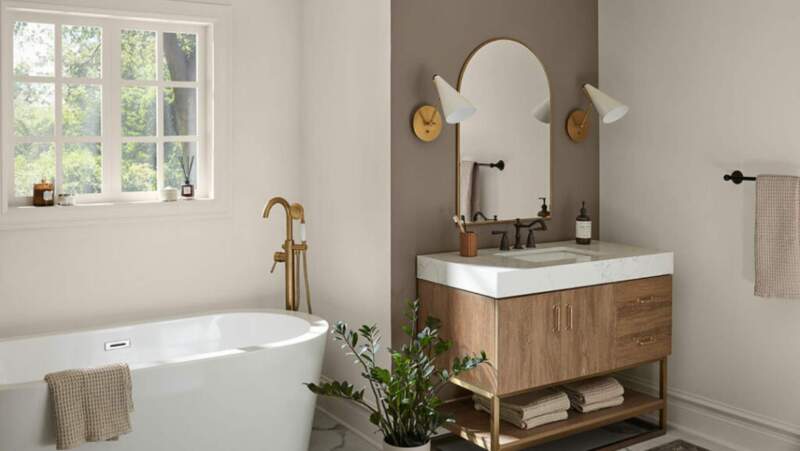Shoji White by Sherwin Williams is the cozy, cooler cousin of classic crisp whites, and it’s quickly becoming a design darling for a reason. Imagine the warmth of a freshly baked cookie, but make it a paint color – that’s Shoji White. It’s a shade that manages to be both inviting and airy, perfect for those craving spaces that feel comfortable without being too stark or sterile.
RELATED BLOG:
- WHAT COLORS GO WELL WITH SHERWIN WILLIAMS TRICORN BLACK?9 PAINTS APPROVED BY INTERIOR DESIGNERS
- THE POPULAR PAINT COLOR COULD RUIN YOUR HOME –ACCESSIBLE BEIGE VS AGREEABLE GRAY
How Shoji White Sherwin Williams makes your small spaces feel bigger:
1. Light and Airy: Highlight the way that Shoji White reflects light and gives the impression of space. The appearance of greater space is ideal for small areas.
2. Cozy, Not Cold: Shoji White’s warmth provides a touch of softness, unlike glaring whites. Talk about how this creates harmony in small areas and prevents them from feeling impersonal.
3. The Chameleon Neutral: Discuss how well the paint works with other neutrals or striking accents. In small spaces where furniture and decor may be more sparsely furnished, adaptability is essential.
4. Say Goodbye to “Cramped”: Describe how ceilings or trim that are painted the same color as Shoji White on walls can obfuscate boundaries. This makes the room appear larger than it actually is.
5. Works with ANY Light: Many whites shift in response to artificial vs. natural light. Draw attention to Shoji White’s constancy, which is important for rooms that receive erratic sunshine.
6. Timeless, Not Trendy: Don’t worry, it won’t go out of style soon. Longevity is a key selling feature for small rooms, which are not given makeover love as frequently.
7. Hides Imperfections: Mention subtly that, in contrast to harsher whites, its warmth is forgiving of modest wall imperfections, which is advantageous in smaller, older homes that may have them.
8. Perfect for [Type of Small Space]: Get specific – Is your blog aimed at small apartment dwellers, tiny bedrooms, and cramped kitchens? Tailor a point to resonate directly.
9. The Budget-Friendly Upgrade: End on a high! Stress that paint is the most affordable way to transform a space, and this particular shade is a guaranteed winner.
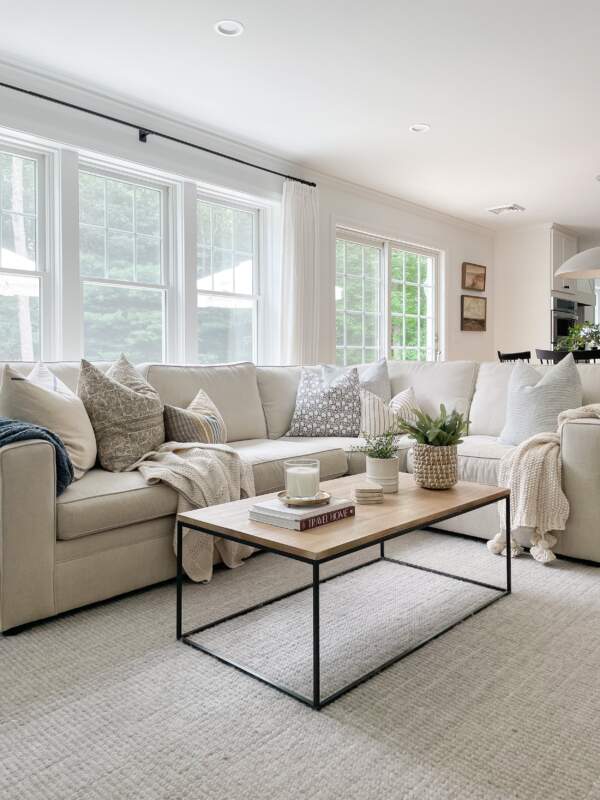
What undertone does Shoji White have?
Shoji White’s primary undertone is a warm beige, often referred to as “greige” (a blend of gray and beige). However, its undertones can subtly shift depending on the lighting:
- Natural Light: In natural light, the beige undertone becomes more prominent, making Shoji White appear warm and inviting.
- Artificial Light: Depending on the type of artificial light (warm or cool bulbs), Shoji White can lean slightly more gray or take on a subtle hint of green.
What is the light reflective value [lrv] of Shoji white?
Sherwin Williams’ Shoji White (SW 7042) has a Light Reflective Value (LRV) of 74.
This is what that implies:
Light Reflectance: Shoji White reflects 74% of the light it comes into contact with, according to its LRV of 74. Because of this, it is a comparatively light hue that enhances space.
Off-White: Because of its warm undertone, Shoji White is nevertheless regarded as off-white even though it reflects a good quantity of light. This sets it apart from stark or pure whites, which were susceptible to LRVs in the 1980s and 90s.
Practicality: For many spaces, an LRV from the 1970s is perfect. Compared to extremely bright whites, it helps bring out natural light and open up spaces while maintaining a warm and welcoming atmosphere.
Is Shoji white darker than alabaster?
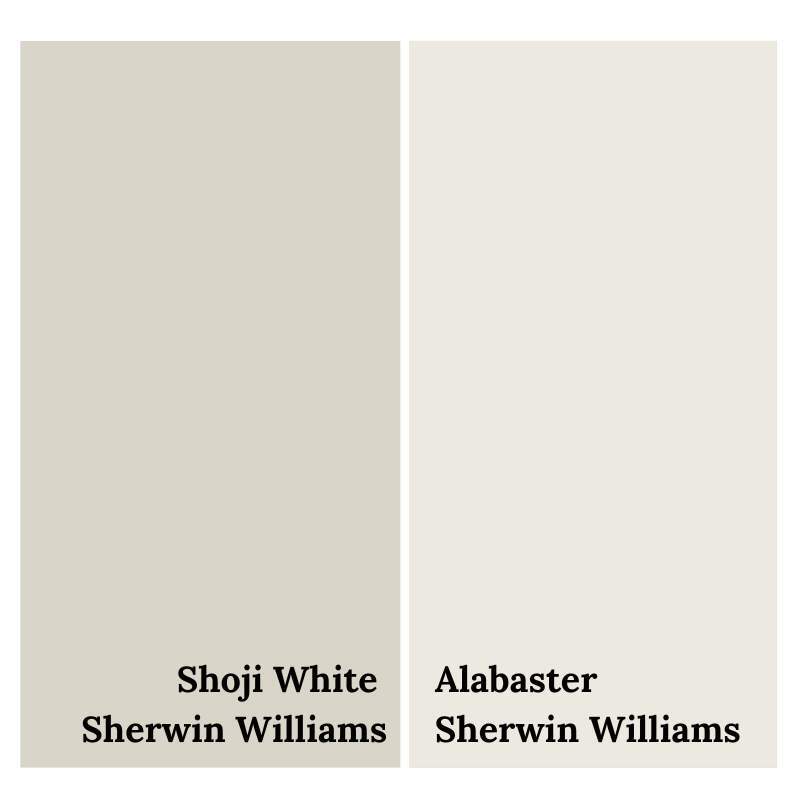
Yes, Shoji White has a little bit more color than Alabaster. This is the reason why:
Undertones: Shoji White has a warm beige undertone, whilst alabaster has a creamy undertone with a hint of yellow. As a result, Shoji White is marginally less brilliant than Alabaster.
Light Reflectance Value, or LRV, is a metric used to determine how much light a paint color reflects. Alabaster will appear brighter overall since it has a higher LRV (82) than Shoji White (74) does.
Consider this: If Alabaster resembles a delicate, off-white color similar to fresh cream, then Shoji White has a little deeper tone like a cup of coffee enhanced with a hint of milk.
Does Shoji white look GREY?
Shoji White’s primary appearance is not always grey; it can occasionally take on a slight greyish tint. Here’s how lighting changes how it looks:
Cooler Lighting: The beige undertone of Shoji White may be less noticeable in spaces with windows that face north, which receive cooler natural light, or in rooms with a large percentage of cool-toned artificial lighting. It might look a little more grey as a result of this.
Warm Lighting: The beige undertones will stand out and any trace of grey will probably vanish in areas with warm-toned artificial lighting or lots of warm natural sunlight.
Colors around: The colors around Shoji White affect how it is perceived. The warm beige undertone will stand out next to pure greys. It may be a tad more grey in comparison to yellows or creams.
Why does Shoji white look pink?
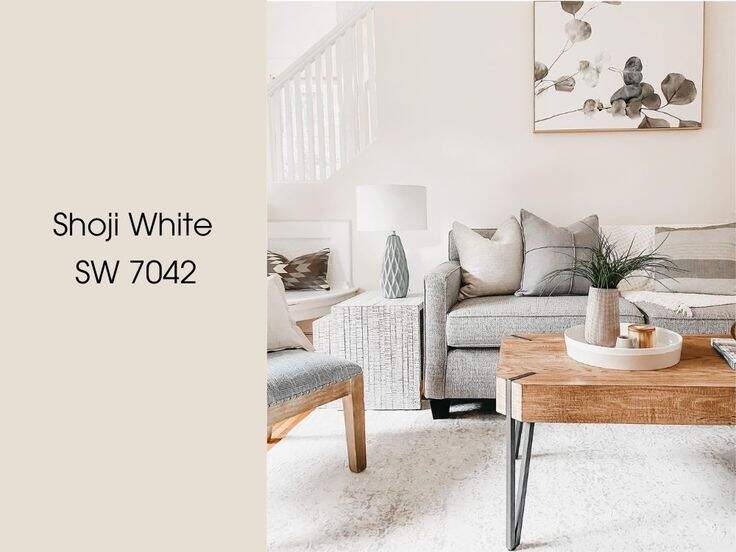
In a few particular situations, Shoji White may seem somewhat pink:
Warm Lighting with Strong Yellows: Shoji White’s faint beige-undertone can combine with extremely warm-toned artificial light that has a strong yellow tint to produce a mild pinkish impression. Particularly in spaces with limited natural light, this is feasible.
Colors of the Surroundings: Shoji White is highly versatile and absorbs colors from its surroundings. The reflections of any pinks, peaches, or even strong reds (furniture, accents, etc.) in the area may give the Shoji White walls a faint pink hue.
Time of Day: Shoji White can temporarily appear more pink-toned when sunlight bounces off of it between sunrise and sunset when sunlight has a very warm, almost pinkish-orange appearance.
Does urbane bronze go with shoji white?

Of course! Shoji White and Urbane Bronze make a chic and well-liked combo. That’s why their collaboration is so effective:
Warmth and Contrast: The darker, richer charcoal of Urbane Bronze, with a hint of brownish-gray undertone, contrasts beautifully with the paler, Shoji White. The outcome is impressive visually without being unpleasant.
Modern Simplicity: The subtle hint of warmth in both hues lends them a sophisticated, modern vibe without being cold or clinical. This combination can be effective in both more classic and contemporary design settings.
Versatility: You may use Shoji White and Urbane Bronze to create a variety of moods. For a stronger look, use Urbane Bronze on furniture, cabinetry, trim, or accent walls.
Does Shoji White go with Snowbound?
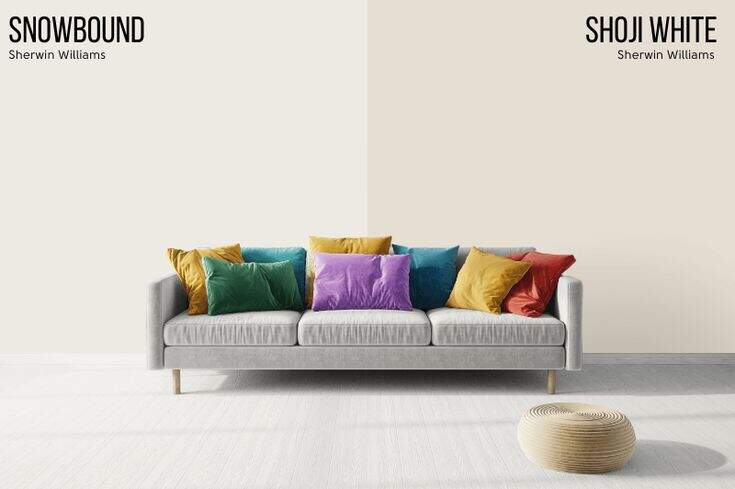
While Shoji White and Snowbound can technically be used together, it’s not the most ideal pairing. Here’s why:
Clash of Undertones: Snowbound has a hint of blue undertones and is a chilly, crisp white. Shoji White has a beige undertone that is warmer. This contrast may give the room a discordant appearance and an unbalanced sense.
Lack of Contrast: When combined, there isn’t much visual contrast because both hues are rather light. This may give the room a washed-out, flat vibe that lacks depth and clarity.
What colors compliment Shoji white?
Shoji White by Sherwin Williams, with its subtle beige undertones and inviting warmth, has become a design darling for its versatility. But what colors truly sing alongside this popular off-white? Let’s delve into a harmonious palette that unlocks the full potential of Shoji White in your space.
Warm Neutrals: A Symphony of Comfort
Accept Shoji White’s comfortable side by matching it with other warm neutral hues. Accessible Beige provides a hint of gentle greige without going too chilly, while Creamy, a somewhat richer white from Sherwin Williams, gives depth and layering. Consider Worldly Gray, a richer greige with a stronger contrast, for a hint of elegance. Urbane Bronze, a rich, warm charcoal, is a startling yet refined accent if you’re looking for a statement item.
Cool Touches for a Balanced Palette
Cool hues that go well with Shoji White’s warmth might add a hint of tranquility. Sherwin Williams’s light and airy blue-gray color silverplate creates a soothing mood. Medium-toned blue-gray Smoky Blue offers a hint of maritime charm or quietly evokes a somber atmosphere. Consider Stardew, a subdued blue-green that adds a dash of brightness from nature, for a cool hint.
Pops of Color: Adding Personality
Don’t be scared to add colorful accents to express your individuality. Sherwin Williams’ classic deep blue color, Naval, gives off a preppy yet elegant vibe. The gentle sage green, Evergreen Fog invites the peaceful spirit of the outdoors within. True black Tricorn Black gives a contemporary edge and looks well as trim or accent. Discover the coziness of rust or terracotta hues, which blend in perfectly with the beige undertones of Shoji White.
Beyond Color: The Magic of Texture and Metallics
Recall that a flawless design is more than just color. To create a harmonious and organic vibe, contrast the warmth of Shoji White with organic textures such as woven fabrics, wood tones, and plants. Incorporate metallic elements such as copper, gold, or brass to accentuate the warmth of Shoji White and give it a more opulent feel.


